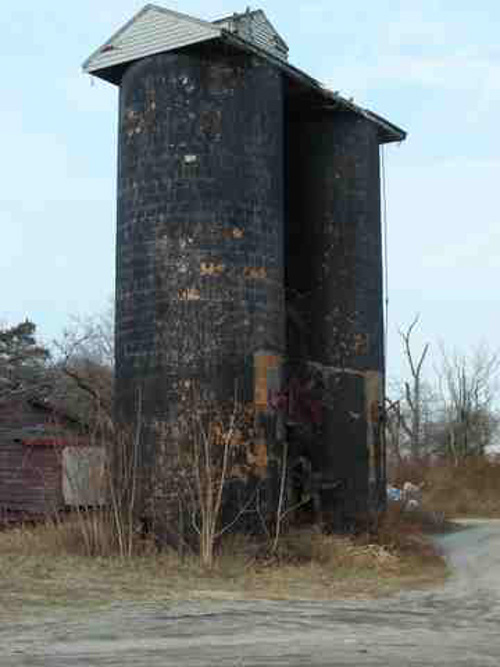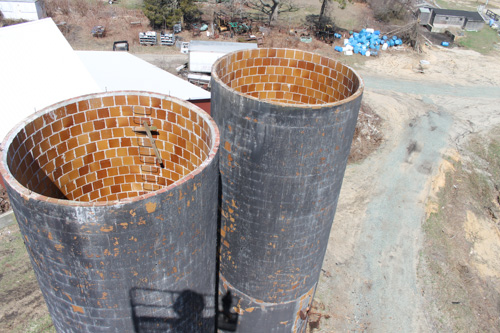The iconic black silos on the Crescent Duck farm, which have towered over Aquebogue for at least a century, will soon be no more.
The 60-foot-tall silos have been sitting in disuse and decomposition for about 50 years, according to Blake Corwin, fifth generation owner of Crescent Duck. “They were never used by us,” he said. “It was time to take them down.”
The tall, dark shape of the silos against the sky is a familiar sight to anyone who lives in Aquebogue. “They were an icon,” Corwin said Wednesday, looking up at the remainder of the silos, surrounded by construction equipment. “You ask someone where the duck farm is, and they might not know where. But they know exactly where the black silos are.”
 Though Corwin isn’t certain of the exact construction date of the silos – his family annexed the property long after they were built – he says he has found photographs of them that date as far back as 1910.
Though Corwin isn’t certain of the exact construction date of the silos – his family annexed the property long after they were built – he says he has found photographs of them that date as far back as 1910.
“They’ve been here for as long as anyone in my family can remember.”
Back in the days of Long Island’s booming duck industry, the silos were used by local farmers to store feed for their ducks. Farmers would come to the silos, open the chute and fill up their trucks, Corwin said.
At the time, Crescent Duck was one of about 70 duck farms in Suffolk County, according to a Suffolk County Department of Planning study. Altogether, Suffolk County duck farms in the ’50s were producing about two-thirds of all duck eaten nationwide.
But Crescent Duck, which acquired the property in the ’60s, had no need for the silos, Corwin said.
“Our feed silos are on the back of our processing plant,” said Corwin. “We didn’t need them for feed, and we never ended up using them for anything.”
Today, Crescent Duck is one of just two duck farms left on the island. The 25-acre property that made up the original farm has been in the Corwin family since the 1650s, when the Corwins originally settled on the East End of Long Island; since the family started farming ducks in 1908, the farm has bought up surrounding land – including the property with the black silos – and grown to be about six times its original size.
 Deconstruction began on Monday, when Corwin began work on the wooden structure sitting atop the silos. “It was completely rotted out,” he said. “I wanted to go at it with a chainsaw, but we ended up needing to just pull it down.”
Deconstruction began on Monday, when Corwin began work on the wooden structure sitting atop the silos. “It was completely rotted out,” he said. “I wanted to go at it with a chainsaw, but we ended up needing to just pull it down.”
The main structure of the silos, which soar about 50 feet in the air, is made out of hollow bricks, which Corwin said was an unusual construction material for similar agricultural structures. He’ll start pulling those down today, and he hopes to have the silos completely dismantled by Friday.
RiverheadLOCAL photos by Katie Blasl
The survival of local journalism depends on your support.
We are a small family-owned operation. You rely on us to stay informed, and we depend on you to make our work possible. Just a few dollars can help us continue to bring this important service to our community.
Support RiverheadLOCAL today.































